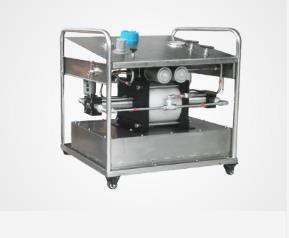Applications of a Hydrostatic Test Pump in Industries
Body
I. Introduction
A. Definition and function of a hydrostatic test pump
A hydrostatic test pump is a specialized device used to generate precise hydraulic pressure, simulating real-world conditions for pressure testing components, systems, and structures.
Its function is to ensure the integrity, safety, and reliability of equipment by subjecting it to controlled pressure levels. This process helps identify leaks, defects, and weaknesses, preventing potential hazards and ensuring compliance with industry standards. Hydrostatic test pumps play a critical role in quality assurance, risk reduction, and maintaining operational excellence across various industries.
B. Importance of pressure testing in various industries
In a variety of industries, pressure testing is crucial for guaranteeing the performance, dependability, and safety of diverse parts, systems, and buildings. Its significance is underscored by its role in avoiding potential hazards, preserving quality, and adhering to industry rules.
II. Applications in Industries
- Construction Industry: Plumbing systems, HVAC equipment, and hydraulic systems are pressure tested to ensure they function as intended and meet safety standards.
- Aerospace Manufacturing: Aircraft components, fuel systems, and hydraulic lines undergo pressure testing to ensure they can handle the stress of flight and maintain safety.
- Automotive Industry: Radiators, fuel tanks, and hydraulic systems in vehicles are tested to ensure they can handle operational pressures and prevent leaks.
- Oil and Gas Sector: Hydrostatic testing verifies the pressure resistance of equipment like wellheads, valves, and pipelines used in exploration, production, and refining processes.
- Chemical Processing: Pressure vessels, storage tanks, and pipelines used in chemical processing undergo testing to ensure they can handle corrosive substances and high pressures safely.
- Manufacturing: Various components in industries such as manufacturing, electronics, and textiles are tested to ensure they meet pressure requirements and quality standards.
III. Safety and Compliance
- Operator Safety:
Hydrostatic test pumps are designed with safety features to prevent over-pressurization, ensuring the safety of operators during testing.
- Pressure Relief Mechanisms:
Modern test pumps are equipped with pressure relief valves or devices that release excess pressure to prevent equipment damage or accidents.
- Certifications and Standards:
Quality hydrostatic test pumps comply with industry standards and regulations, ensuring their reliability and safety during use.
- Material Compatibility:
Test pumps are constructed using materials compatible with the liquids used for testing, preventing chemical reactions or contamination.
- Proper Training:
Operators receive training on the correct operation of hydrostatic test pumps, minimizing the risk of misuse and accidents.
- Inspections and Maintenance:
Regular inspections and maintenance of test pumps ensure their proper functioning, reducing the chances of malfunctions.
- Leak Prevention:
Ensuring that test pumps are leak-tight prevents fluid leakage, protects operators, and maintains accurate pressure testing.
- Electrical Safety:
Electrically powered test pumps have safety features such as grounding and circuit protection to prevent electrical hazards.
It is critical to ensure the safety and compliance of hydrostatic test pumps in order to protect employees, equipment, and the environment while performing precise and dependable pressure testing. Adherence to safety measures and industry standards helps to ensure efficient and secure operations in a variety of industries.
Conclusion
Hydrostatic test pumps are crucial tools for ensuring the safety, quality, and dependability of equipment in a variety of sectors. These pumps detect flaws, prevent leaks, and verify structural integrity by subjecting components to controlled pressures. This procedure not only protects against risks and failures but also guarantees adherence to rules and specifications. Hydrostatic test pumps serve an important role in preserving operating efficiency, decreasing downtime, and establishing confidence in equipment performance, eventually leading to safer workplaces and higher product quality.
Located in Chongqing, China, Chongqing Weiyun Technology Development Co., Ltd. (WINGOIL) is a professional manufacturer of high-pressure and flow control equipment for the oil and gas industry.
Under the guidance of the market, WINGOIL continues to innovate and improve technology to provide customers with safe and reliable pressure test equipment. We can also offer on-site equipment commissioning services to improve customer satisfaction.
If you have any needs, please contact us.












Comments